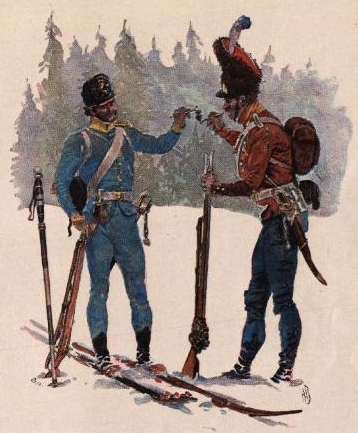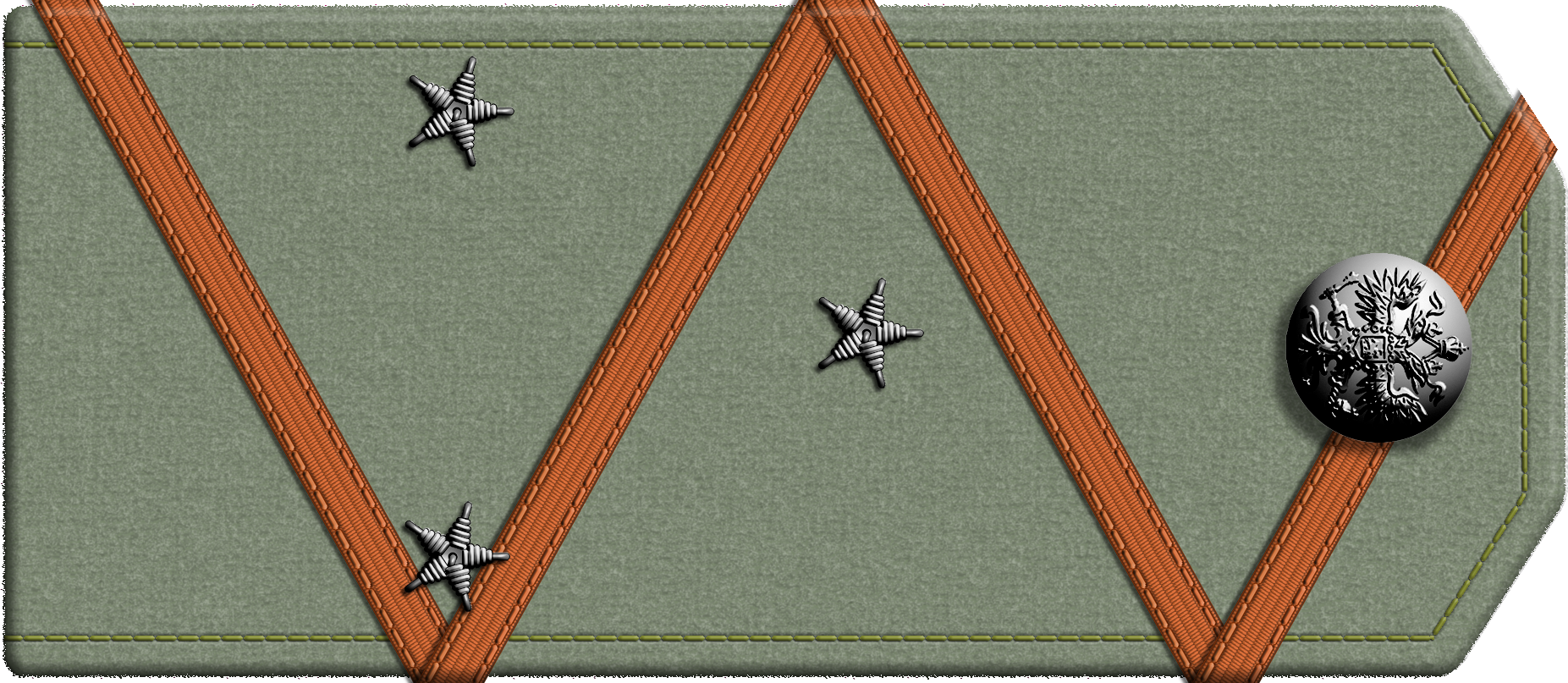|
Finnish III Corps (Continuation War)
The III Corps () was a corps of the Finnish Army during the Continuation War, where Finland fought alongside Nazi Germany against the Soviet Union. Formed from the peacetime V Corps and subordinated to the German Army of Norway (Wehrmacht), Army High Command Norway, III Corps fought initially in northern Finland on the flank of the German XXXVI Corps, participating in the Finno-German Operation Arctic Fox. In February 1944, it was moved to the Karelian Isthmus just prior to the launch of the Soviet Vyborg–Petrozavodsk offensive. Following the Moscow Armistice, III Corps took overall command of the Finnish forces participating in the Lapland War, the removal of German forces from northern Finland. Mobilization and pre-war plans While the exact details of the Finno-Nazi Germany, German planning preceding the Continuation War remain unclear, it is known that on 25 May 1941 Finnish officers participated in negotiations with the Germans in Salzburg regarding plans for a future w ... [...More Info...] [...Related Items...] OR: [Wikipedia] [Google] [Baidu] |
Hjalmar Siilasvuo
Hjalmar Fridolf Siilasvuo (born Hjalmar Fridolf Strömberg, 18 March 1892 – 11 January 1947) was a Finnish lieutenant general (), a knight of the Mannerheim Cross and a member of the Jäger Movement. He participated in the Eastern Front (World War I), Eastern Front of World War I, the Finnish Civil War, the Winter War, Continuation War and the Lapland War. Early life Hjalmar Fridolf Siilasvuo was born as Hjalmar Fridolf Strömberg on 18 March 1892 in Helsinki to newspaper reporter Frans Strömberg and Hulda Röman. He graduated as an ylioppilastutkinto, ylioppilas in 1911 from Svenska normallyceum i Helsingfors and began to study law. During his studies, he became involved in the Jäger Movement, which aimed at sending Finnish volunteers to receive military training in German Empire, Germany. As a member of the movement, Siilavuo left for Germany in early 1915. While in Germany, the Finnish volunteers formed the 27th Jäger Battalion (Finland), 27th Royal Prussian Jäger Battal ... [...More Info...] [...Related Items...] OR: [Wikipedia] [Google] [Baidu] |
Nazi Germany
Nazi Germany, officially known as the German Reich and later the Greater German Reich, was the German Reich, German state between 1933 and 1945, when Adolf Hitler and the Nazi Party controlled the country, transforming it into a Totalitarianism, totalitarian dictatorship. The Third Reich, meaning "Third Realm" or "Third Empire", referred to the Nazi claim that Nazi Germany was the successor to the earlier Holy Roman Empire (800–1806) and German Empire (1871–1918). The Third Reich, which the Nazis referred to as the Thousand-Year Reich, ended in May 1945, after 12 years, when the Allies of World War II, Allies defeated Germany and entered the capital, Berlin, End of World War II in Europe, ending World War II in Europe. After Hitler was appointed Chancellor of Germany in 1933, the Nazi Party began to eliminate political opposition and consolidate power. A 1934 German referendum confirmed Hitler as sole ''Führer'' (leader). Power was centralised in Hitler's person, an ... [...More Info...] [...Related Items...] OR: [Wikipedia] [Google] [Baidu] |
Salla
Salla, known as Kuolajärvi until 1936, is a municipality of Finland, located in Lapland. The municipality has a population of () and covers an area of of which is water. The population density is . The nearby settlement of Sallatunturi is home to the Salla Ski Resort. History Salla is in the Eastern Lapland and as a border area was affected by the Second World War. Red Army troops invaded Finland at Salla during the Winter War but were stopped by the Finnish Army (see Battle of Salla). Parts of the municipality were ceded to the Soviet Union after the war. The ceded part is sometimes called "Old Salla" or ''Vanha Salla''. During the Continuation War the old town of Salla was on the Soviet side of the border. The German XXXVI Corps attacked the Soviet positions in an operation code-named '' Polarfuchs''. With the help of the Finnish 6th Division it managed to occupy all of the ceded territories. At the end of the war the German troops were pushed out of Lapland by Finn ... [...More Info...] [...Related Items...] OR: [Wikipedia] [Google] [Baidu] |
Army Of Norway
The Norwegian Army () is the land warfare service branch of the Norwegian Armed Forces. The Army is the oldest of the Norwegian service branches, established as a modern military organization under the command of the King of Norway in 1628. The Army participated in various continental wars during the 17th, 18th, and 19th centuries as well, both in Norway and abroad, especially in World War II (1939–1945). From December 1951, much of the Norwegian Army was declared for operations as part of Allied Forces Northern Europe, within the NATO Military Command Structure. History Creation of the Norwegian Army After the Kalmar War broke out in 1611, the Danish-Norwegian king, Christian IV tried to revive the leidang, with dire results. As the Norwegian peasantry had not been armed or trained in the use of arms for nearly three centuries, they were not able to fight. The soldiers deserted or were captured. The soldiers had to participate in military drills while providing supplemen ... [...More Info...] [...Related Items...] OR: [Wikipedia] [Google] [Baidu] |
Erik Heinrichs
Axel Erik Heinrichs (21 July 1890 – 16 November 1965) was a Finnish military general. He was Finland's Chief of the General Staff during the Interim Peace and Continuation War (1940–1941 and 1942–1944) and Chief of Defence for a short time after the war (1945). Biography Heinrichs went to the Swedish co-educational school Nya svenska samskolan. He was one of the Finnish Jaeger troops trained in the volunteer Royal Prussian 27th Jäger Battalion between 1915 and 1918. During the Finnish Civil War he served as a battalion commander in the battles of Tampere and Viipuri. He commanded the III Corps in the Winter War, and from 19 February 1940 the Army of the Isthmus. He was made Chief of the General Staff in June 1940 and promoted to General of Infantry in 1941. During the Continuation War he commanded the Army of Karelia until January 1942, after which he was again appointed the Chief of the General Staff. After the war he served as the Army's commander-in-chief b ... [...More Info...] [...Related Items...] OR: [Wikipedia] [Google] [Baidu] |
Berlin
Berlin ( ; ) is the Capital of Germany, capital and largest city of Germany, by both area and List of cities in Germany by population, population. With 3.7 million inhabitants, it has the List of cities in the European Union by population within city limits, highest population within its city limits of any city in the European Union. The city is also one of the states of Germany, being the List of German states by area, third smallest state in the country by area. Berlin is surrounded by the state of Brandenburg, and Brandenburg's capital Potsdam is nearby. The urban area of Berlin has a population of over 4.6 million and is therefore the most populous urban area in Germany. The Berlin/Brandenburg Metropolitan Region, Berlin-Brandenburg capital region has around 6.2 million inhabitants and is Germany's second-largest metropolitan region after the Rhine-Ruhr region, as well as the List of EU metropolitan areas by GDP, fifth-biggest metropolitan region by GDP in the European Union. ... [...More Info...] [...Related Items...] OR: [Wikipedia] [Google] [Baidu] |
Carl Gustaf Emil Mannerheim
Baron Carl Gustaf Emil Mannerheim (, 4 June 1867 – 27 January 1951) was a Finnish military commander, aristocrat, and statesman. He served as the military leader of the White Guard (Finland), Whites in the Finnish Civil War (1918), as List of regents#Finland, Regent of Finland (1918–1919), as Chief of Defence (Finland), commander-in-chief of the Finnish Defence Forces during Finland in World War II, World War II (1939–1945), and as the sixth president of Finland (1944–1946). He became Finland's only Field marshal (Finland), field marshal in 1933 and was appointed honorary Marshal of Finland in 1942. Born into a Swedish-speaking population of Finland, Swedish-speaking family in the Grand Duchy of Finland, Mannerheim made a career in the Imperial Russian Army, serving in the Russo-Japanese War and the Eastern Front (World War I), Eastern Front of World War I and rising by 1917 to the rank of lieutenant general. He had a prominent place in the Coronation of Nicholas II and ... [...More Info...] [...Related Items...] OR: [Wikipedia] [Google] [Baidu] |
Marshal
Marshal is a term used in several official titles in various branches of society. As marshals became trusted members of the courts of Middle Ages, Medieval Europe, the title grew in reputation. During the last few centuries, it has been used for elevated offices, such as in military rank and civilian law enforcement. In most countries, the rank of Field marshal, Marshal is the highest Army rank (equivalent to a five-star General of the Army (United States), General of the Army in the United States). Etymology ''Marshal'' is an ancient loanword from Old French ''mareschal'' (cf. Modern French ''maréchal''), which in turn is borrowed from Old Frankish *' "stable boy, keeper, servant", attested by Medieval Latin ''mariscalcus'' from a Proto-Germanic ''*maraχskalkaz'' (cf. Old High German ''marahschalh'')p. 93b-283a, T. F. Hoad, ''The Concise Oxford Dictionary of English Etymology'' (Oxford University Press, 1993) being still evident in Middle Dutch ''maerscalc'', ''marscal'', ... [...More Info...] [...Related Items...] OR: [Wikipedia] [Google] [Baidu] |
Lake Ladoga
Lake Ladoga is a freshwater lake located in the Republic of Karelia and Leningrad Oblast in northwestern Russia, in the vicinity of Saint Petersburg. It is the largest lake located entirely in Europe, the second largest lake in Russia after Lake Baikal, and the List of lakes by area, 14th largest freshwater lake by area in the world. It is comparable in size to Lake Ontario. ''Ladoga Lacus'', a methane lake on Saturn's moon Titan (moon), Titan, is named after the lake. Etymology In one of Nestor the Chronicler, Nestor's chronicles from the 12th century a lake called "the Great Nevo" is mentioned, a clear link to the Neva River and possibly further to Finnish language, Finnish ''nevo'' 'sea' or ''neva'' 'bog, quagmire'.:ru:Поспелов, Евгений Михайлович, Evgeny Pospelov: ''Geographical names of the world. Toponymic dictionary.'' Second edition. Astrel, Moscow 2001, pp. 106f. Ancient Norse sagas and Hanseatic treaties both mention a city made of lakes named ... [...More Info...] [...Related Items...] OR: [Wikipedia] [Google] [Baidu] |
Salzburg
Salzburg is the List of cities and towns in Austria, fourth-largest city in Austria. In 2020 its population was 156,852. The city lies on the Salzach, Salzach River, near the border with Germany and at the foot of the Austrian Alps, Alps mountains. The town occupies the site of the Roman settlement of ''Iuvavum''. Founded as an episcopal see in 696, it became a Prince-Archbishopric of Salzburg, seat of the archbishop in 798. Its main sources of income were salt extraction, trade, as well as gold mining. The Hohensalzburg Fortress, fortress of Hohensalzburg, one of the largest medieval fortresses in Europe, dates from the 11th century. In the 17th century, Salzburg became a centre of the Counter-Reformation, with monasteries and numerous Baroque churches built. Salzburg has an extensive cultural and educational history, being the birthplace of Wolfgang Amadeus Mozart and being home to three universities and a large student population. Today, along with Vienna and the Tyrol (st ... [...More Info...] [...Related Items...] OR: [Wikipedia] [Google] [Baidu] |
Moscow Armistice
The Moscow Armistice was signed between Finland on one side and the Soviet Union and United Kingdom on the other side on 19 September 1944, ending the Continuation War. The Armistice restored the Moscow Peace Treaty of 1940, with a number of modifications. The Paris Peace Treaties, 1947, final peace treaty between Finland and many of the Allies of World War II, Allies was signed in Paris in 1947. Conditions for peace The conditions for peace were similar to what had been agreed in the Moscow Peace Treaty of 1940: Finland was obliged to cede parts of Karelia and Salla, as well as certain islands in the Gulf of Finland. The new armistice also handed all of Pechengsky District, Petsamo to the Soviet Union, and Finland was further compelled to lease Porkkala Naval Base, Porkkala to the Soviet Union for a period of fifty years (the area was returned to Finnish control in 1956). Territories ceded to the Soviet Union constituted approximately 11.50% (44,106.23 km2) of Finland's ... [...More Info...] [...Related Items...] OR: [Wikipedia] [Google] [Baidu] |








